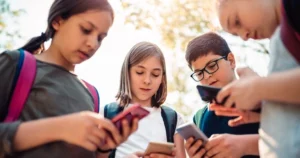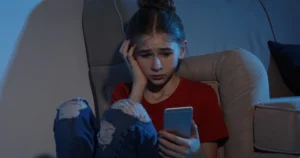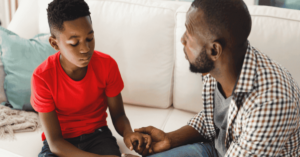Child-on-child abuse online
A guide for parents, carers and teachers
Sometimes called peer-on-peer abuse, child-on-child abuse is online more often now than it once was. Learn what it is, including the signs, and how you can support and inform young people to prevent online child-on-child abuse from happening in schools and at home.
 Close video
Close video
What is online child-on-child abuse?
Online child-on-child abuse is often associated with cyberbullying. However, that is only a part of it. Ofsted explains that it can also include:
- Physical and sexual abuse
- Sexual harassment and violence
- Emotional harm
- Teenage relationships abuse
- Grooming for sexual or criminal exploitation
While schools often receive training for offline child-on-child abuse, only 68% of schools in a survey done by the Marie Collins Foundation suggested they received training for abuse specifically online. In this training, only 48% of schools included all staff. As such, there are key members of staff who may not be appropriately trained to handle online child-on-child abuse.
However, most child-on-child abuse online happens outside of school hours when children are at home and on devices. So, there is also a key part for parents and carers to play in ensuring children and young people are not engaging in these behaviours. Additionally, both teachers and parents need to work together to help young people understand what to do if they find themselves in an abusive situation online.
- Information for parents and carers
- Tips for parents and carers
- What to do if your child is the perpetrator
- Information for teachers and schools
- Tips for teachers and schools
- Tips for children and young people
- Resources to share with students and parents
Information for parents and carers
Parents and carers play a key role in teaching their child about appropriate behaviours online. Have open conversations about what they do online and how they interact with others. Help them understand what healthy behaviours look like and where they can go if they need support.
Insight from Dr Linda Papadopolous
Psychologist Dr Linda Papadopoulos discusses parents’ role in preventing child-on-child abuse in this video. See how it might impact your child and what you can do to support them if they find themselves victim to abuse by another child.
 Close video
Close video
Why children might not report child-on-child abuse and how to support them
“Many times, a child that’s abused has a feeling of guilt about it. They may experience self-destructive thoughts or even a loss of self-esteem or like they don’t deserve to be helped.”
 Close video
Close video
The role of technology in child-on-child abuse
“Kids are with their devices all the time. So, whereas ‘traditional’ peer-to-peer abuse occurs where people are in close proximity, when it’s online, it can occur from anywhere in the world; it could be prolonged; it’s difficult to escape.”
 Close video
Close video
Creating an environment to talk about child-on-child abuse
“There’s a few things you can do. I think the first one is to create time and safe space to talk. Show your child that you are not going to be shocked – that you believe them, that you trust them. Listen to them.”
 Close video
Close video
What you can do to support your child if they are abused
“How do you make your child feel like they’re back in control of what’s going on? It may be that it’s confronting the abuser and maybe telling the other adults in their lives to keep them safe. It may be changing behaviours or changing location so their abuser can’t get a hold of them anymore, whether it’s through their device or at school.”
 Close video
Close video
How schools can support your child
“Explain to the school what’s happening, ask the school what their process is for dealing with this and ask them for clear guidance on how to work together to ensure the child is safe.”
Tips for parents and carers
See what signs to look out for if your child is involved in child-on-child abuse as either the victim or the perpetrator. Learn what you can do to support their recovery and understanding with these expert tips.
Make sure your child or teen understands what child-on-child abuse is by having regular conversations.
Explain to them what inappropriate behaviour looks like as appropriate to their age and empower them to report anything that makes them uncomfortable, even if it’s done by a close friend. It’s important they don’t brush abusive behaviour off as harmless banter.
Improve you knowledge about the different online issues children may face and how they might be targeted.
Most apps, platforms and devices have privacy and security settings users can use to keep themselves safe online.
With your child or teen, set up these controls. Explain how they work and what impact they could have on their safety. Setting them up together can help them develop their understanding and take ownership of their safety.
Get the whole family involved in digital boundaries and online safety with a family agreement.
Just like learning to cross the road safely or getting a road license, accessing everything the online world has to offer needs a certain amount of knowledge, responsibility and resilience.
When they get their first device, help your child learn how to use the internet properly. This could include how to communicate with others and where to get help when they need it.
Go along with them on their journey as they pass milestones like getting a new device or joining social media platforms to help them have positive interactions with others.
Signs that a child might be a victim of child-on-child abuse could include:
- Self-harm
- Changes in their normal behaviour
- Knowledge of things inappropriate for their age
- Substance abuse
- Problems with sleep
- School avoidance
- Unexplained injuries
Make space for what they might be feeling as a result of child-on-child abuse. Listen to how they feel – sad, angry, scared – and let them know that it’s okay to feel those things as long as you support them as they heal.
However, children and young people who have been abused tend to blame themselves, and it’s vital that you challenge these feelings of guilt. Their abuse didn’t happen to them because they did something wrong. It is not their fault; they did not deserve the abuse. Help them externalise these thoughts instead of placing the blame on themselves.
If you are aware of child-on-child abuse that the school is not, it is critical that you inform them so they can put their own safeguards in place to protect your child. Ask them about their policies and their process for dealing with the issue; ask them for clear guidance on what you can do as their guardian.
What to do if your child is the perpetrator
If you discover your child has targeted another child in some way, it might be hard to deal with. Below are some tips to help for you to help them learn from their mistakes and find support.
What are the signs?
Behaviours associated with a child who may be abusive towards another child include:
- A need to control or assert dominance
- Aggression
- Impulsivity
- Short-temperedness
- Lack of empathy
- Easily frustrated
- Less likely to take responsibility for their actions
Hold them accountable
It’s important that inappropriate behaviour isn’t ignored or written off as a one-time indiscretion. It needs to be challenged. Work with their school to sort out consequences and help educate them on appropriate behaviour.
Educate them
In many cases, they may not realise that sending a nude or sharing violent videos or treating a friend poorly is abusive behaviour. Teach them about child-on-child abuse and why the actions they took are wrong. See our guide for children and young people.
Have calm conversations
It is easy to get angry if you find your child behaving inappropriately. However, speaking to them calmly to understand why they took the actions they did can help them understand their mistakes. It may also uncover additional needs they have that you can get support for.
Get support for yourself
Depending on the severity of the abuse, you may feel stressed or stretched to your limits. To be fully able to support your child, you need to support yourself. Talk to organisations like Family Lives and YoungMinds to get support and advice for how to move forward.
Information for teachers and schools
Teachers and schools are often charged with providing care for children that extends beyond education. In many cases, they are at the forefront of safeguarding and pastoral issues. However, when it comes to child-on-child abuse online, they don’t always feel prepared.
A report from the Marie Collins Foundation found that 90% of respondents experienced incidents of online child-on-child abuse in their school but only 68% reported that they received training for this.
Tips for teachers and schools
This section has advice to help support teachers and schools in creating an environment that supports children and young people who may be victims or perpetrators.
See what signs may present themselves if your students are involved in child-on-child abuse as either the victim or the perpetrator. Learn what you can do to support their recovery and understanding with these tips created with the help of online safety expert, Karl Hopwood.
Teachers and school staff should be aware of the different types of child on child abuse and have opportunities to talk about specific cases.
What is child-on-child/peer-on-peer abuse?
KCSIE (Keeping Children Safe in Education) references different forms of child-on-child abuse:
- Bullying (including cyberbullying, prejudice-based and discriminatory bullying)
- Abuse in intimate personal relationships between children
- Physical abuse
- Sexual violence and sexual harassment
- Consensual and non-consensual sharing of nude and semi-nude images
- Causing someone to engage in sexual activity without consent
- Upskirting (taking a photo under someone’s clothing without their permission)
- Initiation/hazing type violence and rituals.
It is important to report/log even the smallest concerns that you might have. Although it may appear insignificant, it could be crucial when seen as part of a bigger picture or a pattern of behaviour over a longer period of time. The DSL (Designated Safeguard Lead) will have the overview when many (indeed most) other staff will not.
Teachers and schools need to be supportive about any incidents that have taken place outside of the school setting and also adopt an “it could happen here” stance.
It is important to not dismiss child-on-child abuse as “banter” or “part of growing up” or “just having a laugh” or “boys being boys”. This is clearly highlighted in KCSIE and it is crucial that young people are not given the impression that this is the view of the school or staff. Everyone should be clear that their concerns will be taken seriously.
Remember that it can be incredibly difficult for children and young people to talk about child-on-child abuse. As such, schools should make every effort to create safe spaces where young people can talk about what has happened to them.
Be clear about the process, don’t make promises to keep what they tell you secret if there are safeguarding concerns but explain what will happen if someone discloses child-on-child abuse.
Reporting routes are vitally important, and young people should be aware of what is available. As they get older, they are less likely to speak to a parent/carer or teacher and are more likely to try and deal with it themselves. Schools should clearly signpost possible reporting routes:
- The Mix – an advice service for those under 25 to seek help on a variety of issues.
- Report Harmful Content (UK Safer Internet Centre) – designed to assist everyone over 13 in reporting harmful content online. Schools can also install a button directly on their website.
- Internet Watch Foundation (UK Hotline) – for reporting illegal content online like child sexual abuse images.
- Report Remove Tool (Childline) – this helps children under 18 remove nude or semi-nude images that have been shared.
Tips for children and young people
Children and young people may struggle to understand what online child-on-child abuse looks like and how/where they can report this behaviour or get support. This guide offers useful tips and guidance so they can stay safe and feel confident online.
From the comments you make on social media to how you interact with people in video games, positive interactions help people feel happy and safe online. That also means calling out or reporting behaviour that isn’t so positive.
If you see bullying behaviours online or at school (even if you’re not sure), help the victims by reporting it to a trusted adult or on the platform itself.
And think about your words before you comment or say them. How will the other person feel when they hear or read what you say and how does it reflect on you?
Healthy behaviours make people feel good about themselves. And they make you feel good about yourself too!
Support people online by following, liking, commenting nice messages and playing video games together.
But think twice before commenting negative messages — insults, spamming, things to put people down — or before taking and sharing images without permission from the people in them (including strangers).
Would you want a random picture of yourself shared with people you might not know?
Recognise what child-on-child abuse looks like so you can help stop it from happening. Anything that makes another young person feel uncomfortable or unsafe because of another young person could be child-on-child abuse.
Keep an eye out and report anything you think could be abusive. Even if you have your doubts, it’s better to report it and be wrong than ignore it and be right!
All smartphones and apps have their own privacy and security settings. With a trusted adult, set these up to help you feel safe online.
Keep accounts private, turn off image-sharing settings like AirDrop, and set your social feeds up so they only show content that you are interested in. Learn how to report and block things that make you feel unsafe or uncomfortable.
You have a powerful voice that can put an end to anything that makes you or someone else feel unsafe or uncomfortable.
Some people worry that no one will listen or that it will only make it worse, but keeping silent will make sure nothing ever gets better. So make sure you report everything — big or small — and keep reporting it.
Tell a trusted adult like a parent, carer or teacher. Or, if you don’t feel comfortable talking to someone you know, you can call/text/message services like Childline and The Mix to speak with someone anonymous.
Resources to share with students and parents
Explore more online issues
Featured online safety issues articles
 Research
Research
Children’s Wellbeing in a Digital World – Index Report 2025
This report is fourth in an annual series evaluating and tracking impacts of technology on children's digital wellbeing across four different areas.
 Expert opinion
Expert opinion
What tech-facilitated abuse looks like in teenage relationships
Lauren Seager-Smith from The For Baby's Sake Trust explores what tech-facilitated abuse looks like in relationships and how to keep teens safe.
 Research
Research
Our recommendations for media literacy in the school curriculum
As the Government reviews the school Curriculum, we highlight the importance of improving media literacy education.
 Research
Research
Parents and children say: Ban nudifying apps
Our policy manager shares our perspectives from parents and children on banning nudifying tools as nude deepfakes rise.
How to best use location tracking apps within your family
Location tracking apps via smartphones are a common way to keep track of your child outside of the home.





